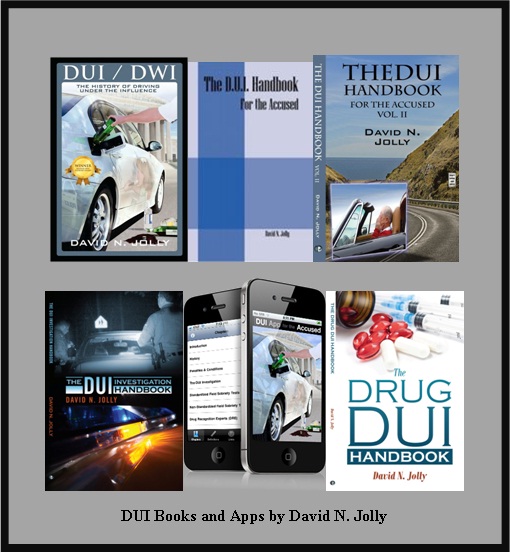Available for purschase at: http://www.amazon.com/DUI-DWI-History-Driving-Influence/dp/1432746227/ref=sr_1_3?ie=UTF8&s=books&qid=1258400052&sr=1-3
Horizontal Gaze Nystagmus (HGN)
The technical definition of nystagmus is that it is the rhythmic back and forth oscillation of the eyeball that occurs when there is a disturbance of the vestibular (inner ear) system or the oculomotor control of the eye. Although techniques for accurately measuring nystagmus were developed in the 20th century, nystagmus was positively linked to vestibular stimulation as early as the 19th century. Tatler, BW, Wade, NJ. On nystagmus, saccades, and fixations. Perception. 32(2):167-184, Page 167 (2003)
There are two major types of eye movements: pendular and jerk. Pendular nystagmus is where the oscillation speed is the same in both directions. Jerk nystagmus is where the eye moves slowly in one direction and then returns rapidly. Most types of nystagmus have the fast and slow phase (jerk nystagmus). Horizontal Gaze Nystagmus (HGN), which is the type of nystagmus used in DUI investigations, is a type of jerk nystagmus with the jerky movement toward the direction of the gaze. Adams, Raymond D. & Victor, Maurice. Disorders of Ocular Movement and Pupillary Function. Principles of Neurology. Ch.13, 117 (4th ed. 1991)
Like most types of nystagmus, HGN is an involuntary motion, meaning the person exhibiting the nystagmus cannot control it or is even aware of it. Forkiotis, C.J. Optometric Exercise: The Scientific Basis for Alcohol Gaze Nystagmus. 59 Curriculum II, No. 7 at 9 (April 1987); Good, Gregory W. & Augsburger, Arol R. Use of Horizontal Gaze Nystagmus as a Part of Roadside Sobriety Testing. 63 Am. J. of Optometry & Physiological Optics 467, 469 (1986); Stapleton, June M. et al. Effects of Alcohol and Other Psychotropic Drugs on Eye Movements: Relevance to Traffic Safety. 47 Q.J. Stud. on Alcohol 426, 430 (1986)
Critics of the horizontal gaze nystagmus test for DUI (alcohol) related purpose have argued that alcohol is not the only potential cause of nystagmus and in fact there are many different causes of nystagmus that have been observed and studied. Syndromes such as influenza, vertigo, epilepsy, measles, syphilis, arteriosclerosis, muscular dystrophy, multiple sclerosis, Korsakoff’s Syndrome, brain hemorrhage, streptococcus infections, and other psychogenic disorders all have been shown to produce nystagmus. Additionally, conditions such as hypertension, motion sickness, sunstroke, eyestrain, eye muscle fatigue, glaucoma, and changes in atmospheric pressure may result in gaze nystagmus. Pangman. Horizontal Gaze Nystagmus: Voodoo Science. 2 DWI J. 1, 3-4 (1987)
Further, these same critics have argued that alcohol is not the only drug to cause nystagmus and that caffeine, nicotine, or aspirin also lead to nystagmus almost identical to that caused by alcohol consumption. Id. at 3-4. Finally, conditions such as a person’s circadian rhythms or biorhythms can affect nystagmus readings as the body reacts differently to alcohol at different times in the day and even fatigue nystagmus can be found in an individual, and the list, according to critics, goes on. Id. at 3-4; Booker, J.L. End-position nystagmus as an indicator of ethanol intoxication. Sci Justice. 41(2):113-116. (April – June, 2001)
For information on your DUI, please contact our Snohomish County DUI attorneys, King County DUI attorneys, Island County DUI attorneys, or Skagit County DUI attorneys at 425-493-1115 or check out our website at http://www.washdui.com/


No comments:
Post a Comment